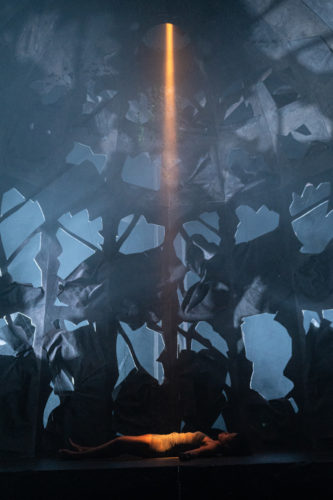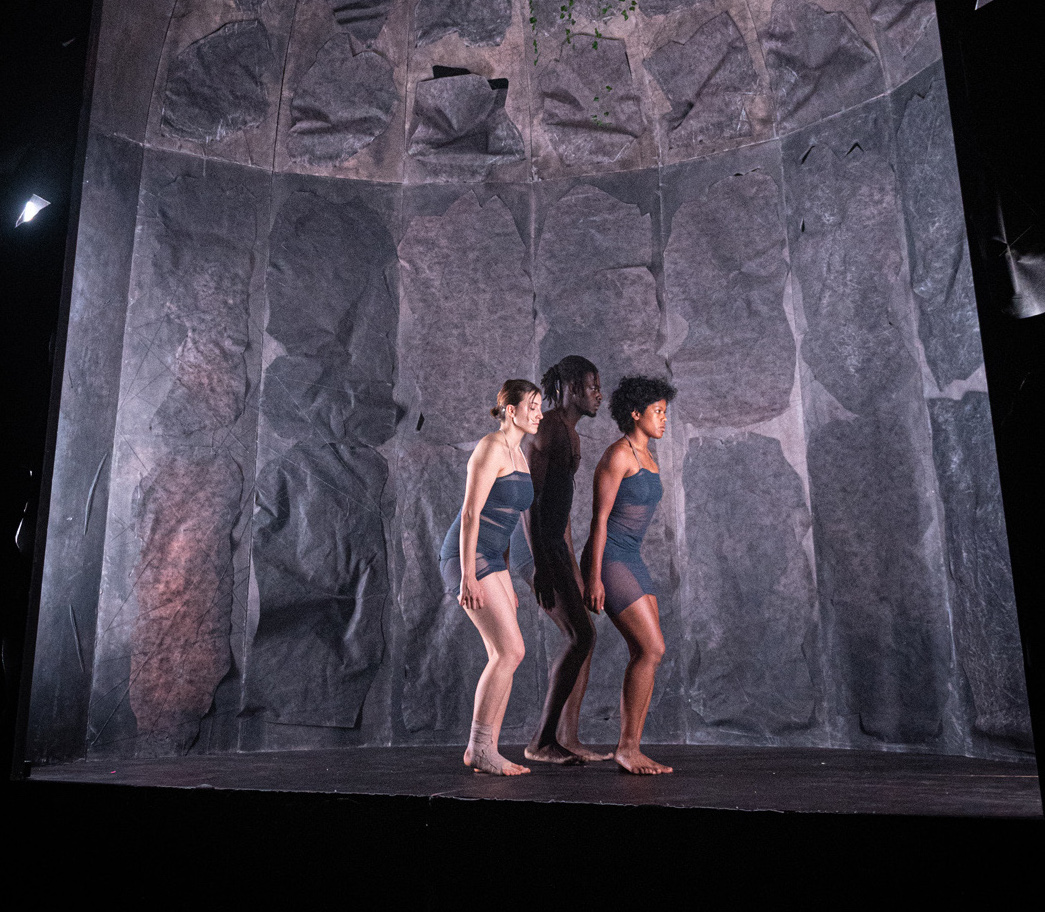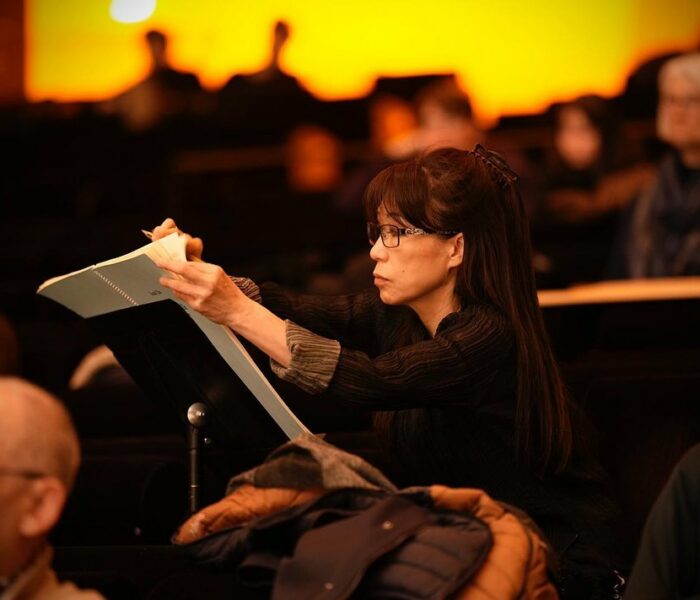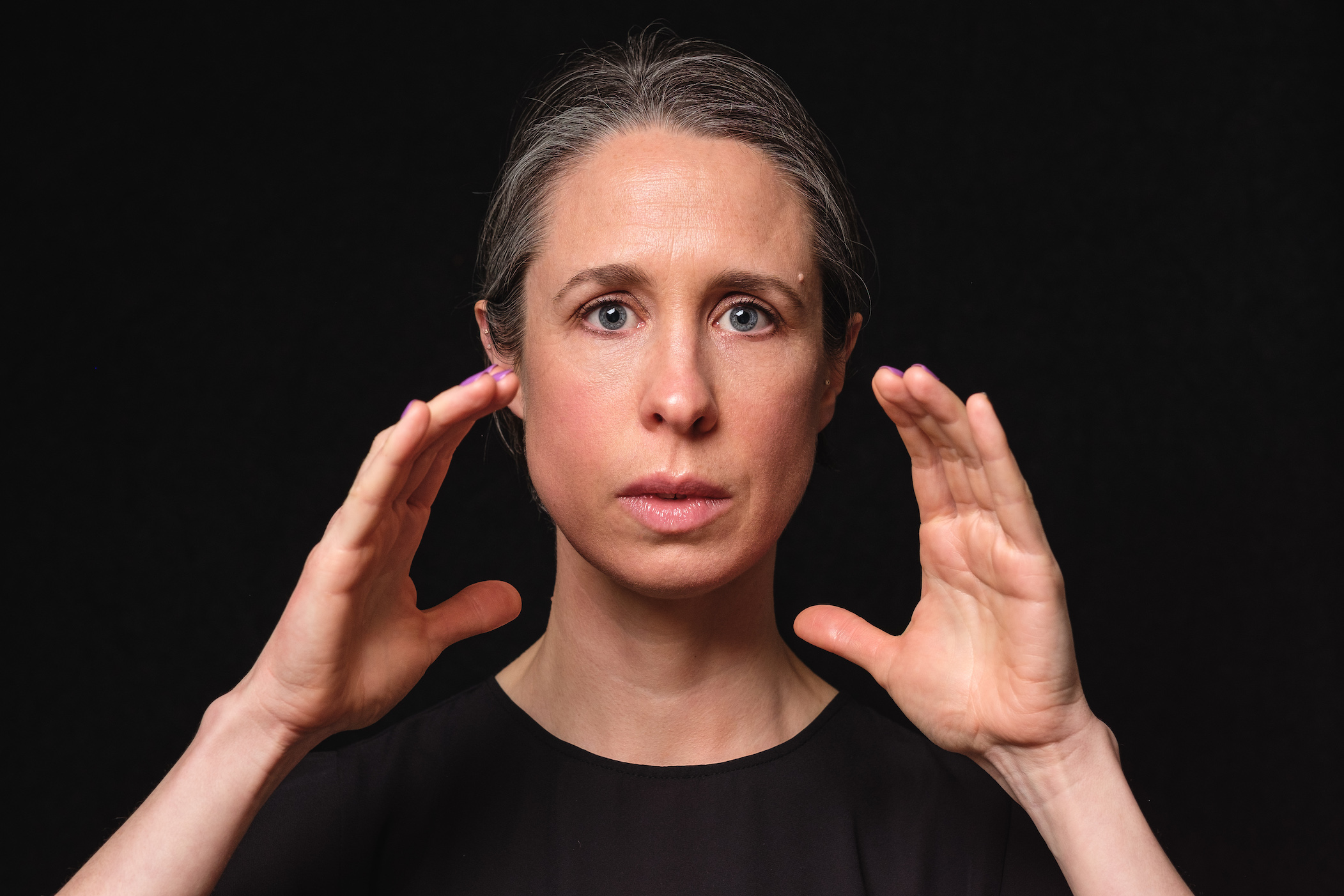C’est sous le signe du croisement des arts et de l’hybridité que Christian Sebille, directeur du Gmem (Centre national de création musicale de Marseille) a pensé cette deuxième édition du festival Propagations, en misant sur la diversité des propositions (concerts mais aussi installations) et la présence de la jeune génération. Ce à quoi répondent les deux derniers spectacles du festival, donnés à la Friche La Belle de Mai, un espace foisonnant dédié à la création où le Gmem a élu domicile.
Moving voices
Investissant le grand plateau, Reaching Out (Moving Voices), spectacle chanté, joué et dansé, est une œuvre collective, conçue dans sa globalité par le compositeur tchèque Ondřej Adámek et son partenaire et chorégraphe Éric Oberdorff ; Reaching out (Tendre la main) est un projet empreint de spiritualité, une trajectoire initiatique à travers laquelle l’être humain poursuit sa quête de sens et d’identité. Entre les deux pièces d’Adámek, placées au début et à la fin du parcours, s’entendent en création celle de la toute jeune Japonaise Rino Murakami (Salmon crossing) et du compatriote tchèque Martin Smolka, (Stretto). Si l’œuvre collective reste encore, assez rare, elle tend à se répandre au sein de la nouvelle génération de créateurs.
Le spectacle débute dans le silence, laissant les participants venus des rangs du public – six chanteurs, deux percussionnistes et deux danseurs – se mettre en situation de jeu : ils se déchaussent et déposent en bord de scène un bouddha : sorte de cérémonial instaurant d’emblée la dimension rituelle que souligne un geste de la main exécuté par tous les interprètes.
Knock Earth Stone Dust (Frappe Terre Pierre Poussière) d’Adámek, qui dirige à cour et parfois se mêle au collectif, met en jeu la pierre, sonore, précieuse, mais aussi celle que l’on jette et qui tue : « J’ai reçu une pierre en pleine tête », lit-on dans les cinq poèmes en anglais de l’auteur islandais Sjón qu’a choisis le compositeur. Les pierres entrechoquées, les mots pulsés par les chanteurs et le corps des danseurs sont autant de sources énergétiques exploitées et amplifiées par la percussion et son set d’instruments pléthoriques. Adámek sait révéler la qualité sonore du mot et son potentiel à devenir musique sans jamais abandonner la valeur sémantique et narrative du texte : l’allusion à la Passion du christ (« que celui qui n’a jamais péché parmi vous jette la première pierre sur elle… ») met en scène l’évangéliste (voix féminine soliste) et le chœur de foule dans un passage particulièrement intense. La fluidité est totale entre les trois instances, instrumentale, vocale et gestuelle, et la synergie exemplaire au sein d’une écriture liant mouvement et émotion (Moving voices).
Une autre lutte, aussi ludique que tragique, s’instaure dans Salmon crossing, celle des saumons kéta (dans l’État de Washington) traversant la route en période d’inondation pour regagner leur rivière d’origine. « De nombreux saumons ne parviennent pas à retrouver leur chemin vers le cours d’eau et meurent », explique la compositrice Rino Murakami dans sa note d’intention. Bruits de bouches, chuintement, halètement, ondulation d’une plaque de métal évoquent le milieu aquatique et les poissons dans l’effort tandis qu’un texte japonais (Salmon Song ) traduit en anglais sert de trame dramaturgique à cette courte pièce parlée autant que chantée, jouée autant que dansée, affichant une dimension plus théâtrale.



Prière du soir
Les crotales jouées par le chef font transition. L’action s’immobilise tout comme les percussions, exceptés les deux vibraphones installés sur le devant de la scène, pour un instant de prière et une écoute recueillie auxquels nous invite Martin Smolka dans Stretto. Le compositeur tchèque met en musique un vieux texte spirituel en latin tournant autour de l’idée de lumière divine. Elle s’incarne dans la voix aérienne de Steve Zheng chantant un hymne à la vierge sous la résonance des lames de vibraphone frottées par les archets ; les litanies qui lui succèdent sont quasi a cappella, les mots répétés à différentes vitesses par les six voix formant des textures micropolyphoniques fragiles et aux dynamiques variées : « des mantras qui vénèrent la Sainte Vierge jusqu’à la transe », précise le compositeur.
Gute Nacht
L’énergie revient en force avec les pompes à air qu’Adámek met dans les mains des chanteurs et danseurs dans la dernière pièce Schlafen gut. Warm qu’il dirige face au public et en fond de scène. La langue allemande provient des lettres écrites par son grand-père, sorti clandestinement du camp de concentration de Theresienstadt et de son arrière grand-mère morte à Auschwitz : l’humour éloigne ici le pathos, Adámek mettant en scène tout à la fois la respiration vitale (« nous devons toujours être en bonne santé », écrit le grand-père) et le voyage en train qui conduit au camp de concentration : soufflerie de la locomotive, rythme obsédant jusqu’à l’exaspération entretenu par les voix en onomatopées et la percussion ; un voyage au bout de la nuit et jusqu’au dernier souffle qu’évoquent avec un formidable engagement les voix et corps en mouvement : « les frontières entre les formes d’expression vocale s’estompent de plus en plus, tout comme les fonctions des chanteurs, des instrumentistes, des danseurs et du chef d’orchestre », souligne Adámek, pointant l’hybridité des genres et la « main tendue » entre les formes d’expression et les êtres qui motivent chaque nouvelle création chez notre compositeur rayonnant d’humanité.
« Habiter la ruine » avec Florentin Ginot
La voix n’est pas chantée dans Dead trees give no shelter (Les arbres morts n’offrent pas d’abri) mais parlée, et avec un grain singulier, celui de Frédéric Stochl, incarnant le rôle de Tirésias, le devin aveugle de Thèbes aux mamelles ridées, est-il ajouté avec humour. L’homme enlève un à un ses vêtements noirs qu’il avait superposés et les abandonne sur le sol, balisant leur trace d’un signal blanc. Côté musique, Florentin Ginot, artiste à l’origine du projet, est à jardin avec sa contrebasse amplifiée, donnant à entendre un autre grain, peaufiné par l’archet et traité par le dispositif électronique sous le contrôle de Martin Antiphon à la console de projection. Les trames sombres, aux textures charnues et richement granulées proviennent des machines analogiques (modulateur en anneau, filtres, thérémine, synthétiseur modulaire Buchla, etc.) installées à cour, celles de Helge Sten, figure de la « dark ambient » norvégienne, dont le son monte en puissance jusqu’aux limites de l’audible : la musique est à écouter avec le corps, incandescente et vrombissante lorsqu’elle déferle par vagues dans une séquence où la contrebasse mène avec elle une lutte déloyale. Dans l’imposante structure en quart de sphère implantée au centre du plateau évoluent les corps des trois danseurs, Soa Ratsifandrihana, à qui l’on doit la chorégraphie, Julie Richalet et Germain Zambi, grand spécialiste du Krump, cette danse urbaine visant à exalter la vie et toute sa jouissance qu’il donne à voir, avec ses partenaires, dans un trio électrisant. Un premier « court-circuit » (il y en aura deux) démantèle la structure et génère, sous les lumières de Marie-Hélène Pinon, de superbes images hantées par la présence fantomatique des danseurs/acrobates sur les hauteurs.



Car il est question d’érosion dans cette proposition à plusieurs entrées, montrant des corps qui se dénudent, une matière qui s’altère et des mouvements qui fléchissent – la très belle scène de Pietà en souligne la plasticité. La contrebasse (façon viole de gambe) de Florentin Ginot cite Henry Purcell dans un lamento évoluant sur sa basse chromatique obstinée (ground). Frédéric Stochl, alias Tirésias, revient sur scène pour dire des extraits du long poème de T.S. Eliot, the Wast Land (La Terre vaine) qui projette ses images de sécheresse – « la montagne de roc sans eau » -, le comédien esquissant même quelques pas de danse accompagnés par la contrebasse.
L’imagination est à l’œuvre dans un spectacle qui saisit tout à la fois l’œil et l’oreille, éprouve les sens et suscite l’interrogation à travers un geste fort et une réalisation de haute tenue d’artistes – interprète, compositeur, danseur et comédien – dont le talent force l’admiration.
Michèle Tosi



)



